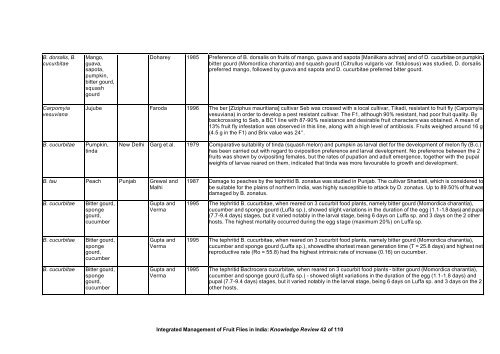“Key Informant Survey” of Production, Value, Losses and ... - DfID
“Key Informant Survey” of Production, Value, Losses and ... - DfID
“Key Informant Survey” of Production, Value, Losses and ... - DfID
You also want an ePaper? Increase the reach of your titles
YUMPU automatically turns print PDFs into web optimized ePapers that Google loves.
B. dorsalis, B.<br />
cucurbitae<br />
Carpomyia<br />
vesuviana<br />
Mango,<br />
guava,<br />
sapota,<br />
pumpkin,<br />
bitter gourd,<br />
squash<br />
gourd<br />
B. cucurbitae Pumpkin,<br />
tinda<br />
Doharey 1985 Preference <strong>of</strong> B. dorsalis on fruits <strong>of</strong> mango, guava <strong>and</strong> sapota [Manilkara achras] <strong>and</strong> <strong>of</strong> D. cucurbitae on pumpkin,<br />
bitter gourd (Momordica charantia) <strong>and</strong> squash gourd (Citrullus vulgaris var. fistulosus) was studied, D. dorsalis<br />
preferred mango, followed by guava <strong>and</strong> sapota <strong>and</strong> D. cucurbitae preferred bitter gourd.<br />
Jujube Faroda 1996 The ber [Ziziphus mauritiana] cultivar Seb was crossed with a local cultivar, Tikadi, resistant to fruit fly (Carpomyia<br />
vesuviana) in order to develop a pest resistant cultivar. The F1, although 90% resistant, had poor fruit quality. By<br />
backcrossing to Seb, a BC1 line with 87-90% resistance <strong>and</strong> desirable fruit characters was obtained. A mean <strong>of</strong><br />
13% fruit fly infestation was observed in this line, along with a high level <strong>of</strong> antibiosis. Fruits weighed around 16 g<br />
(4.5 g in the F1) <strong>and</strong> Brix value was 24°.<br />
B. tau Peach Punjab Grewal <strong>and</strong><br />
Malhi<br />
B. cucurbitae Bitter gourd,<br />
sponge<br />
gourd,<br />
cucumber<br />
B. cucurbitae Bitter gourd,<br />
sponge<br />
gourd,<br />
cucumber<br />
B. cucurbitae Bitter gourd,<br />
sponge<br />
gourd,<br />
cucumber<br />
New Delhi Garg et al. 1979 Comparative suitability <strong>of</strong> tinda (squash melon) <strong>and</strong> pumpkin as larval diet for the development <strong>of</strong> melon fly (B.c.)<br />
has been carried out with regard to oviposition preference <strong>and</strong> larval development. No preference between the 2<br />
fruits was shown by ovipositing females, but the rates <strong>of</strong> pupation <strong>and</strong> adult emergence, together with the pupal<br />
weights <strong>of</strong> larvae reared on them, indicated that tinda was more favourable to growth <strong>and</strong> development.<br />
Gupta <strong>and</strong><br />
Verma<br />
Gupta <strong>and</strong><br />
Verma<br />
Gupta <strong>and</strong><br />
Verma<br />
1987 Damage to peaches by the tephritid B. zonatus was studied in Punjab. The cultivar Sharbati, which is considered to<br />
be suitable for the plains <strong>of</strong> northern India, was highly susceptible to attack by D. zonatus. Up to 89.50% <strong>of</strong> fruit was<br />
damaged by B. zonatus.<br />
1995 The tephritid B. cucurbitae, when reared on 3 cucurbit food plants, namely bitter gourd (Momordica charantia),<br />
cucumber <strong>and</strong> sponge gourd (Luffa sp.), showed slight variations in the duration <strong>of</strong> the egg (1.1-1.8 days) <strong>and</strong> pupal<br />
(7.7-9.4 days) stages, but it varied notably in the larval stage, being 6 days on Luffa sp. <strong>and</strong> 3 days on the 2 other<br />
hosts. The highest mortality occurred during the egg stage (maximum 20%) on Luffa sp.<br />
1995 The tephritid B. cucurbitae, when reared on 3 cucurbit food plants, namely bitter gourd (Momordica charantia),<br />
cucumber <strong>and</strong> sponge gourd (Luffa sp.), showedthe shortest mean generation time (T = 25.8 days) <strong>and</strong> highest net<br />
reproductive rate (Ro = 55.8) had the highest intrinsic rate <strong>of</strong> increase (0.16) on cucumber.<br />
1995 The tephritid Bactrocera cucurbitae, when reared on 3 cucurbit food plants - bitter gourd (Momordica charantia),<br />
cucumber <strong>and</strong> sponge gourd (Luffa sp.) - showed slight variations in the duration <strong>of</strong> the egg (1.1-1.8 days) <strong>and</strong><br />
pupal (7.7-9.4 days) stages, but it varied notably in the larval stage, being 6 days on Luffa sp. <strong>and</strong> 3 days on the 2<br />
other hosts.<br />
Integrated Management <strong>of</strong> Fruit Flies in India: Knowledge Review 42 <strong>of</strong> 110

















